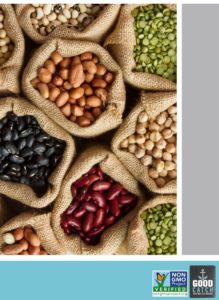 In the developed world, we eat, on average, too many animal products. In fact, we eat way too many animal products. Not just too many for our own health, but too many for the health of the planet. These animal proteins aren’t just delicious, they’re valuable sources of protein, which is vital to growth, tissue repair, and other important stuff like helping your blood clot. We wouldn’t get very far without protein in our diet. So what’s a hapless, protein-dependent life form to do? Lucky for us, cutting back on the creature flesh has never been easier or tastier. That empty spot on our plates (and in our hearts) previously occupied by steak can now host one of the many plant-based meat alternatives, from the humble veggie burger to the latest in non-GMO seafood.
In the developed world, we eat, on average, too many animal products. In fact, we eat way too many animal products. Not just too many for our own health, but too many for the health of the planet. These animal proteins aren’t just delicious, they’re valuable sources of protein, which is vital to growth, tissue repair, and other important stuff like helping your blood clot. We wouldn’t get very far without protein in our diet. So what’s a hapless, protein-dependent life form to do? Lucky for us, cutting back on the creature flesh has never been easier or tastier. That empty spot on our plates (and in our hearts) previously occupied by steak can now host one of the many plant-based meat alternatives, from the humble veggie burger to the latest in non-GMO seafood.
Read more about the meat-eating in the modern age
Leggo My Legumes
When it comes to plant-based protein sources, which plants should we choose for our daily dose? Your best bet is to sample a variety of different ones. (*Insider tip: “a variety” is often the answer to what kinds of foods you should eat.) Legumes — edible seeds or pods that grow on plants in the Fabaceae or Leguminosae family — include some of the top contenders like beans and peas. According to Dr. Meir Stamplfer of Harvard, "Replacing red meat with legumes can reduce the risk of diabetes and cardiovascular disease and even certain forms of cancer. They make a good exchange for red meat because they contain many of the same nutrients, but fewer of the drawbacks.”
Mixing several sources of plant-based proteins can also improve digestibility and provide more of the essential amino acids which make up proteins. Plus, any time we choose a plant-based food over an animal-based one, we make a sustainable and resource-efficient choice. That’s a good reason to think of animal products in your diet as more of a treat than a staple.
While legumes are great plants providing quality proteins, it’s still important to choose non-GMO. Soybeans, for example, are the largest crop grown in the US, but 94 percent of soy is genetically engineered for herbicide tolerance. That means unless you see the Non-GMO Project Verification mark, those potential protein sources come with a hefty dose of glyphosate, dicamba, or 2-4D — toxic chemicals whose use has increased dramatically since the introduction of GMOs.
#CatchtheQs
This week, the Non-GMO Project is offering a Q&A on plant-based meat alternatives and non-GMO legumes. Check out our Instagram and Facebook stories to participate! And we’ll see you here next week for part two of our deep dive on legumes. It’s a meaty topic.
